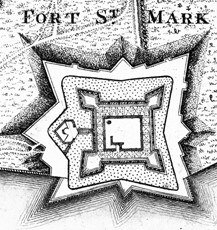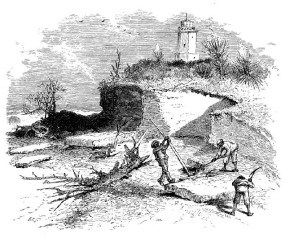|
The Castillo de San Marcos is unique in North American architecture. As the only extant 17th century military construction in the country and the oldest masonry fortress in the United States it is a prime example of the Vauban style of fortifications, and the culmination of hundreds of years of military defense engineering. 
Bastion SystemOriginating in Italy in the 15th century the particular star shaped design of the Castillo is a result of architecture adapting to technology. The change in warfare brought about by black powder weapons created new types of defensive structures adapted both to withstand or avoid the impact of cannon projectiles and to effectively mount cannons to repel any attackers. Of the major architectural variations the "bastion system," named for the projecting diamond or angle shaped formations added onto the fort walls, was the most commonly and effectively used. 
The Stone That Saved Spanish FloridaGiven its light and porous nature, coquina would seem to be a poor choice of building material for a fort. However the Spanish had few other options; it was the only stone available on the northeast coast of La Florida. However, coquina's porosity turned out to have an unexpected benefit. Because of its conglomerate mixture coquina contains millions of microscopic air pockets making it compressible. |
Is it a Fort or a Castle?A very interesting question. The short answer is: Both. Both is good. It really depends on who used it and what purpose the structure served. Merriam-Webster Dictionary defines a castle as "a large fortified building or set of buildings; a retreat safe against intrusion or invasion." Oxford English Dictionary says it is "a large building, typically of the medieval period, fortified against attack with thick walls, battlements, towers, and in many cases a moat." The Real Academia Española states it is "a strong place, surrounded by walls, bastions, moats, and other fortifications."
|
Last updated: April 10, 2025
